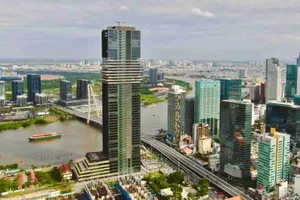Despite the central bank’s cap on the credit growth to below 20 percent this year, many commercial banks continued to raise their registered capital, triggering questions how they manage the fund effectively in difficult times.

Researches from the National Financial Supervisory Commission show the return-on-asset (ROA) and return-on-equity (ROE) ratios of local lenders have decreased since 2008.
The move is in contrast to foreign banks’ worldwide, which dropped significantly in 2008 and rallied strongly in the next two years.
Financial experts said the decrease came from the fact that local banks carried out an inefficient operation in spite of the big deficit between lending and saving rates, with the increasing bad debt ratio.
Many banks tried to expand their branch network as many as possible in an attempt to boost their asset, but they had to pay for that wrong step as their branches’ revenue was hit hard by the central bank’s limit on the lending growth rate this year.
Prime Minister Nguyen Tan Dung has cut the target for credit growth this year to less than 20 percent from 23 percent and ordered a tighter monetary policy as costlier fuel and electricity and a weaker currency stoke inflation. The central bank raised its refinancing and repurchase rates on April 1 and plans to boost reserve ratios for dollar deposits in May.
The expense-on-asset rate increased to 2 percent from 1.8 percent, especially the rate of some banks surged to 2.3-2.5 percent. The rising expense will definitely not only reduce banks’ income rate, but also weaken their risk resistance, analysts warned.
In theory, lenders with the expense-on-total-asset ratio of less than 1 percent can resist a bad debt rate of 15 percent, but they will struggle with the 5 percent bad debt rate if the expense-on-total-asset ratio rises to 2 percent.
Surveys from National Financial Supervisory Commission show 400 listed companies have low instant liquidity rates, amounting to an average of 1.98 percent only.
The inventory rate of businesses in some sectors including footwear and textile showed signs of increasing this year, which will hurt their liquidity ratio, the commission warned, adding that businesses with low liquidity will grapple to repay loans.
Analysts noticed that commercial banks are now struggling to find out businesses with healthy financial results, while their share price was constantly diluted by additional share issues.
“Investments in government bonds will be profitable if lenders are allowed to rediscount the bonds with a coupon rate that is lower than the bond’s,” an economist in HCMC told Dau Tu Tai Chinh Newspaper.
“However, they mobilized capitals with very high depositing rates, so buying the government bond with a coupon rate of 12.5 percent per annum is not a good option.”
The government has boosted interest rates and cut the country’s target for credit growth in an effort to contain consumer prices. The central bank on Wednesday increased its repurchase rate to 14 percent from 13 percent. The rate has now doubled since November.
Vietnam’s monthly inflation rate in April was 3.32 percent, the fastest since 2008. The country’s year-on-year inflation rate in April reached 17.51 percent, also the fastest since 2008.












)

)









